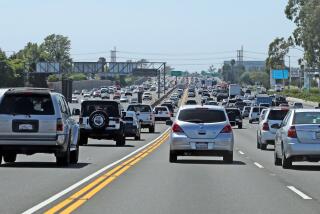Thousand Oaks Enters Fast Lane of Information Superhighway : Technology: City will host an advanced communications test site. Residents will learn to do business by computer--and perhaps stay off the road.
Thousand Oaks will soon boast the state’s first telecommunications test center, a research facility that will show residents high-tech ways to consult doctors, question teachers or train employees simply by tapping a few computer keystrokes.
In a pilot project administered by Caltrans, the federal government will put up $1.2 million for an Advanced Telecommunication Center designed to evaluate the practical applications of emerging technology.
By stacking the center with dozens of cutting-edge programs, Caltrans officials hope to teach residents how to transact daily business through computers.
Ultimately, Caltrans wants to persuade residents to go on-line rather than on the road.
“We want to study how to use telecommunications as a means of avoiding a trip,” program Coordinator Margaret Moilov said. “How to bring services to you instead of having you drive to the services.”
The technology on display, for example, could show teen-agers how to view the hottest fashions by tapping into a computer video hooked up at a mall. Families might be able to organize virtual-reality reunions with faraway relatives. And accountants might be able to check their clients’ books through the magic of videoconferencing.
Thousand Oaks leaders admit they don’t quite understand the newfangled technology. But they know the Advanced Telecommunications Center will become a speedy on-ramp to the information superhighway.
*
The city will contribute $14,000 to the telecommunications center, plus space at the Civic Arts Plaza now under construction.
“We are very lucky to have this opportunity,” Councilwoman Judy Lazar said. “And the potential for improving our air quality (by reducing driving) could be a big secondary benefit.”
Already, private funds have wired part of the city for the 21st Century: GTE California has installed fiber-optic cables in a new development on the west end of town.
If GTE receives federal and state approval, the company could begin transmitting entertainment and information services over the fiber optics, which are capable of transmitting a huge volume of clear and crisp television and voice signals.
Residents hooked up to the system will someday be able to call up movies, monitor the stock market or pay their bills simply by pushing buttons on their TV remote controls.
Even those outside the GTE test neighborhood will be able to use computer modems to transact daily business, once Thousand Oaks’ electronic bulletin board switches on-line this summer.
The bulletin board will allow residents to read City Council agendas, register for marriage licenses, make building inspection appointments and even buy tickets for shows at the Civic Arts Plaza.
“I don’t think these things will change the character of this city, but (the technology) will cause us to think of new ways of doing things,” said Shirley Cobb, the city’s media services manager.
“It’s very exciting,” Cobb added. “The cities that look at this developing technology now will be in a wonderful position to benefit” as the information superhighway expands.
*
Slated to open early next year, the Advanced Telecommunications Center will feature several components. Most will be set up in the Civic Arts Plaza, but officials also envision mobile units that will travel to classrooms, businesses and homes.
The center will include:
* A teleconference room allowing business people to hold cross-country or even overseas meetings through video screens, providing that the partners have compatible software.
* A mobility-management program offering up-to-the-minute information, in both English and Spanish, on traffic, road conditions and public-transit options.
* A job training center allowing employers to instruct workers at various sites through a single video program.
* An exploratorium, featuring hands-on exhibits of the nation’s most advanced telecommunication projects.
Caltrans officials will monitor each program, hoping to pinpoint the most popular technologies. By the end of the two-year pilot project, they should be able to advise cities throughout California about which communication systems nudge the most commuters out of their cars.
As they gear up for the Thousand Oaks center, officials said they have not yet determined whether to charge residents to use the technology.
*
But they emphasize that they hope to make the programs available to everyone. Indeed, plans call for setting up community test sites to evaluate how youngsters, disabled residents, health care providers and other individuals respond to the new technology.
Based on a few months of market research, Caltrans officials expressed confidence that Thousand Oaks residents will clamor to join the test groups.
“You have an exceptional community,” Moilov told city leaders at Tuesday’s City Council meeting. “Your residents are very receptive to new concepts and technology.”
Plus, Moilov said, Thousand Oaks residents have an incentive to consider using telecommunications instead of their cars: “You have a suburban community that’s heavily impacted by congestion, traffic and air-quality issues.”
More to Read
Sign up for Essential California
The most important California stories and recommendations in your inbox every morning.
You may occasionally receive promotional content from the Los Angeles Times.










